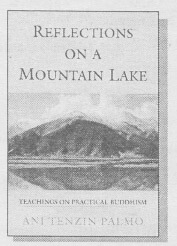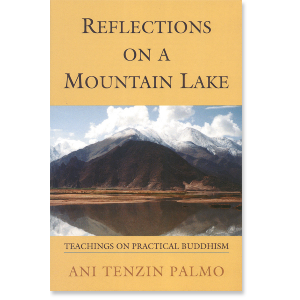| The following article is from the Winter, 2003 issue of the Snow Lion Newsletter and is for historical reference only. You can see this in context of the original newsletter here. |

Reflections on a Mountain Lake was named one of the top ten spiritual books of 2002 in a December article in USA Today. The book was written by Ani Tenzin Palmo and published by Snow Lion.
The list of the year's top religion books, which was compiled by the editors of the interfaith Web site Beliefnet, offers an "amazing tour of the American spiritual landscape," said Steve Waldman, founder and CEO of Beliefnet.
Ani Tenzin Palmo is the subject of the well-known book Cave in the Snow. Reflections on a Mountain Lake: Teachings on Practical. Buddhism is 260 pp. and is available for $16.95.
Here is an excerpt:

It is very important for us to motivate ourselves before we start to practice. Otherwise, when the initial flush of enthusiasm wears off, the mind starts to become bored and easily distracted. For this reason, when people start shamatha practice, they are advised to do very short sessions. We have to be skillful and work with our minds, not against them. There are two ways to approach this. One is to sit for one hour or maybe even three hours and just stay with it. Regardless of what arises, we don't get up and ran out of the room screaming. We just sit there and go through it. The other way is to say to ourselves, "Let's be kind to our mind. Let's work with the mind." After all, we have to make the mind want to concentrate. If we are reading a book we find excruciatingly boring, it will be very difficult to remember what it's about. There will be this inner conflict—a desperation in the mind to do anything rather than read this material, and so it's very difficult for us. There is "me," and then there's this book which I'm forcing myself to read. But if we are reading something which really fascinates us, we are not even conscious that we are reading because it's a joy. We put the book down when necessary with great regret and can hardly wait to pick it up again. We can achieve something similar without practice. Some people tell me that because they have very active minds which have been intellectually trained, it's boring for them to meditate. This is a problem many of us share.

The way to get the mind interested is, as I said, to keep the meditation periods very short when we first begin. The reason for this is that the mind can retain interest in almost anything for a short time. If we over- extend, however, it begins to get restless. It does this even if its interested, because it is not used to remaining focused on one point for an extended period. Then, when we try to meditate again, there will be inner resistance because the mind remembers it got bored last time. Whereas if we stop before we get bored, while we're still enjoying it, the mind remembers that it had fun before, and wants to do it again. Therefore it is often advised, at least in the Tibetan tradition, that our shamatha sessions be short but frequent. Short means whatever we feel comfortable with. Less than ten minutes would not be of much use. I think twenty minutes is about right. It takes about ten minutes just to get the mind to quiet down. If we stop the session as soon as the mind becomes quiet, its too soon. However, if we keep on too long, the mind reaches its peak and attention starts to dissipate. If we stop it at that point, we've gone too long. It's really best to stop the meditation just as the mind reaches its peak and just before it begins to dip down. When you find the mind getting weary, you can stop for a few minutes, look around, then start again.


